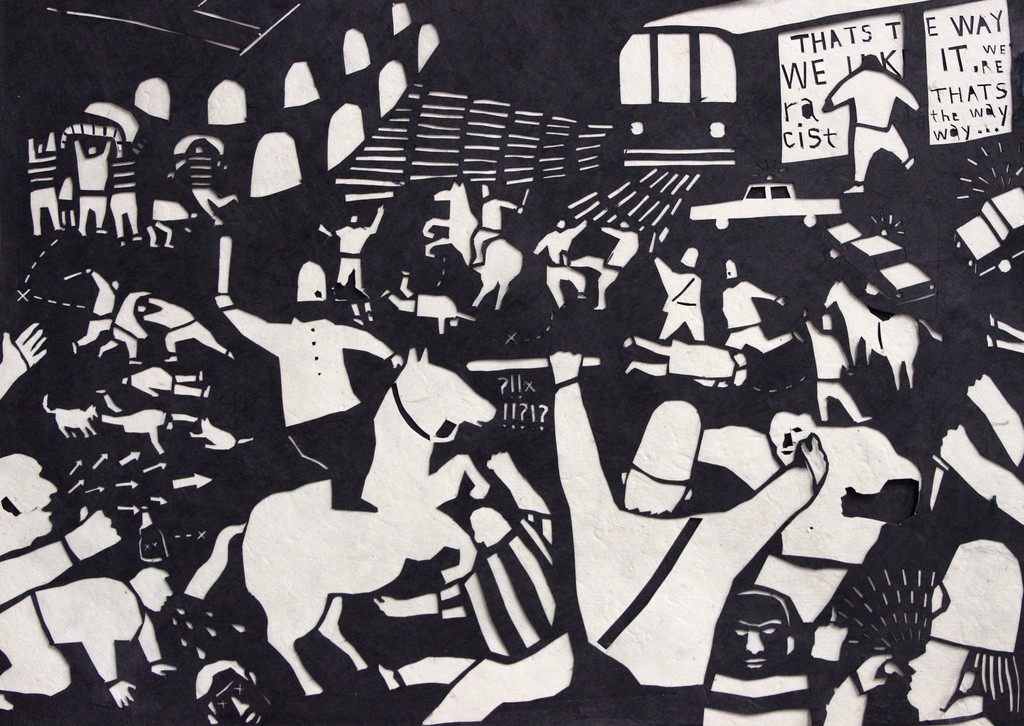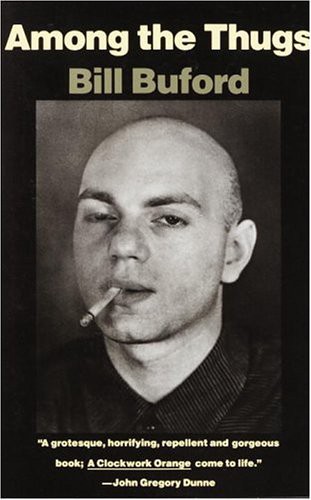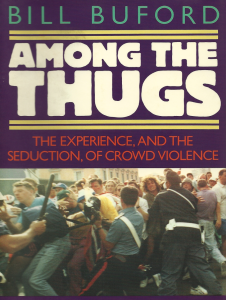The beautiful game still has an ugly underbelly. Why does this abusive element, and our perverse fascination with it, endure?

The song lasts a devastating ten seconds on the low-res video. Its words are initially hard to discern. A group of men on a train car are attempting to harmonize. In another place or at another time they might have been praised for revealing something of their feelings, making a show of love, baring their souls. But not this place, not this time, not these men.
The place: the Paris metro.The time: the aftermath of a Champions League Football match.The men: fans of Chelsea Football Club. They reveal their innermost feelings in the form of a song, though it does not deserve that label. It’s a chant, a hate rant. Before breaking out in song, they repeatedly shove a black man, preventing him from boarding the train car. Their words give me shivers: “We’re racist, we’re racist, and that’s the way we like it, we like it, we like it…” Those words, so easily sung, ring in my ears. They stick in my mind, where they cannot easily escape. Who could sing such a song?
I know who they are: hooligans, yobbos, thugs. I want to deny their existence, to pretend that they are no longer part of my England. I thought they’d been banished to the history books. For me, these scenes feel ripped from the pages of Among The Thugs, Bill Buford’s devastating account of English soccer hooligans in the 1980s.

I first read Among The Thugs over two decades ago, while in my early twenties. I had yet to start a family and was nostalgic for the English upbringing I so yearned for, an upbringing that was my right but that I never had, having moved as a child to New York City from Winchester, England with stops in Leeds (I should probably be a Leeds United fan) and New Haven along the way. I came away horrified, very much as I am horrified whenever I hear of an account of thuggery associated with my beautiful game: A Fenerbahçe fan stabbed to death in Turkey, a policeman killed at a match between Catania and Palermo, a Toulouse fan murdered in Belgrade.
In the mid-to-late Eighties, when Buford wrote Among the Thugs, hooliganism was seen as a particularly English pursuit. Since then, it has sometimes felt like England’s rich game — the all-seater game, the international game, the game that sold three seasons of UK broadcast rights for over £5 billion — has more or less tamed the yobbos. But, as the Paris metro incident and a recent video showing West Ham fans singing anti-Semitic songs prior to a match against Tottenham demonstrate, tamed is too strong a word. The rich game has only succeeded in displacing the hooligans. They’ve moved from the stands to side streets and the tube stations.
Being English, is it proper to confess that I feel lucky that hooliganism is no longer solely associated with English soccer fans? Hooliganism has gone global. On the eve of the 2014 World Cup, a wave of protests and violence roiled Brazil as the poor and disenfranchised rallied against the money and excess of this most global of tournaments. The most astonishing headline to come out of these protests read: “A Brazilian Soccer Fan Is Killed by Tossed Toilet Bowl.” “Fans ripped three toilet bowls from the restrooms at Arruda Stadium and tossed them from the stands,” reported Jaime Urribari of the New York Daily News. “One of them struck a man identified as Paulo Ricardo Gomes da Silva, killing him instantly.” I was disgusted by the senseless nature of the act and the horrific manner of this man’s death.
With that act of toilet bowl terror in mind, I decided to reread Buford’s book. I wanted to revisit what made it a great read and how it made me think of my birth nation. This was also an occasion to reflect on the connection between my favorite sport and the horrors of the Thugs. And now, in light of more recent events, I fear that my game will never be rid of the hooligans.

Buford’s journey into the hooligan world starts, quite literally, at a railway station in Wales, where chanting Liverpool supporters overtake a train. The thugs’ antics initially seem mostly harmless — isn’t that how Douglas Adams describes Earth in The Hitchhiker’s Guide to the Galaxy? These are college pranks tinged with an angry, anti-social edge. Even during this, my second reading, I started the book hoping that the pranks wouldn’t evolve into the hate and terror I knew is coming. I enjoyed this second honeymoon period, blissfully ignorant of the evil acts to come. But they must come, much as I may have wished to enjoy Buford’s prose and characterizations and somehow suspend my knowledge of the violence. Because that is what it is — there is no other word. Violence.
The first supporter Buford becomes truly involved with, a Manchester United fan named Mick, is deliciously intriguing. Buford is as impressed with Mick’s linguistic dexterity — he utilizes words such as wanker and cunt — as he is with Mick’s appetite. He takes stock of his match day rituals: “In addition to a newspaper full of fish’n’chips, his two cheeseburgers, his two meat pies, his four bags of bacon-flavored crisps, and the Indian take-out order he was about to purchase on his way to the station, Mick had had the following: four cans of Harp lager, a large part of a bottle of Tesco’s vodka, and eighteen pints of bitter. As the pub closed, Mick bought a further four cans of lager for the train ride home.”
Mick introduces us to a wild cast of characters, a collection of reasonably sympathetic clowns: Banana Bob, Barmy Bernie, Bone Head, Daft Donald, One-Eye Billy, Paraffin Pete, Red, Robert the Sneak Thief, Sammy, Speedie.
I felt like a rubber-necker trying to catch a glimpse of a pile-up on my commute home. I was enthralled by the behaviour of these man-children
In spite of my better judgement, I wanted to know more about the Micks of the world. I felt like a rubber-necker trying to catch a glimpse of a pile-up on my commute home. I was enthralled by the behaviour of these man-children: the drunken louts, acting like college frat boys, swilling beer and playing pranks. I identified with their stupidity, their scams, their freedom, their rule breaking, their challenging of authority. I fell for their the carefree attitude. Over the course of a few hours in Turin they moon locals from a bus, chant “Fuck the Pope”, get blind drunk, and commandeer the town square. Some of the thugs’ exploits are stunningly preposterous: taking over a charter plane from Turin, ignoring passport control and immigration and stowing away on the flight (“being on the jib”) so as not to spend any money. They are just that little bit lovable, like your drunk uncle at Christmas who passes out on the couch after dinner and spills a glass of red wine into his lap.
Then the mood turns and the violence begins. Those same clowns are now running riot. I went from being awed to sickened. Buford’s eight years among the thugs take him from Manchester to Turin, from Cambridge to Fulham, and to Dusseldorf and Sardinia. I found myself troubled as I reread passages from the book. Buford attends a QPR match and every time a black player has a touch, the stands issue a strange grunting sound, “uggh, uggh, uggh.” The author tells us that the sounds were coming from “everyone on the terraces-old, young, fathers, whole families.” In an attempt to picture that moment, I imagined the more recent scene in the Paris metro. What is it about these people? Are they well and truly racist? They must be. Do they have any excuse? Is this what they’ve always done, what they have taught their children to do?
In what is surely the most disturbing scene in the book, Buford describes Harry, who, in a fight with a policeman, head butts the off-duty copper and then proceeds to suck one of the man’s eyeballs out of its socket. Buford recalls that he kept going “until he felt it pop behind his teeth. Then he bit it off.” How do you react to this moment? Twenty years after first reading Thugs, I still didn’t know. Horror and disgust were the first two words that popped into my head, as quickly as the eyeball must have popped out of the copper’s. But I was also amazed by book’s language and Buford’s skill as a raconteur much as I was amazed by the daring of Harry’s actions — his reckless, violent, sociopathic, angry, vengeful actions.
Among The Thugs is in large part concerned with the power of belonging and the corresponding fear and hatred of others. “The supporters did not like the stranger,” Buford writes. “The foreigner was the one they really hated.” These fans travel abroad to stand apart from foreign cultures and, if at all possible, fight them. Toward the end of Thugs Buford suggests they “wanted an England to defend.” “They wanted a war,” he continues. “They wanted a nation to belong to and fight for.” To me this xenophobia exhibited on foreign soil is no different than intra-city or intra-national hostility. In global terms Liverpool and Everton fans are no different; the same holds for United and City or for Fenerbahçe and Galatasaray; Rangers and Celtic fans have differences of religion but they are not really so different. Do angry fans merely desire someone, anyone to hate, to vent their anger against?
So what are these thugs: are they ordinary, disaffected youth, drunk and out for a bit of fun, or are they serious lawbreakers, stompers, racists, xenophobes? Can they be both?

When I first read Thugs, I believed that acts of violence, particularly those connected to sport, were a fairly recent development. Like the very rules of the game itself, I believed these acts had originated in Britain. I have since learned that the first sports riots occurred in Constantinople in 531. Known as the Nika Riots, over 30,000 people were killed fighting over chariot racing teams know as the Blues (Chelsea, anyone?) and the Greens. The first recorded use of the word hooligan came in 1894, in reference to a gang of London youth.
Buford examines the dynamics of the crowd: its formation, its power, its feelings as it turns violent. He writes about crowd leadership and planning, citing the writings of Plato and Freud. This analysis, however, is not what makes Thugs the great read that it is. The pages devoted to the science and philosophy of rioting feel shoehorned into the text, as if Buford felt the need to defend his wild adventures with the louts. Buford’s documentary effort doesn’t need to be intellectualized; it’s enough to show the behavior. The theorizing can be left to the social scientists.
Among the Thugs’ biggest asset is the intensity of Buford’s accounts. He expertly conveys the experience of being in the eye of the storm. In the book’s most revealing passage, Buford writes of a rioter: “ Somebody near me said that he was happy. He said that he was very, very happy, that he could not remember ever being so happy…” I wonder how a man’s most joyous moment could come in a riot. I’m fascinated by how he can take pleasure from violence and vandalism. While it is interesting to know how and when the crowd crosses over the boundary from relative peacefulness and calm to one of extreme violence and destruction, I find Buford’s personal observations and documentary approach more instructive.
And what of recent football violence? Although the frequency and intensity of fan violence has decreased in Britain, fighting does persist. In 2009, Millwall fans, whose defiant slogan is “no one likes us, we don’t care,” rioted with West Ham United supporters. A man was stabbed. According to The Guardian, ticketless fans showed up solely for the purpose of starting trouble. In April 2014, after his team’s 0–3 home loss to fierce rivals Sunderland, a drunk Newcastle fan punched a police horse named Bud. He was subsequently sentenced to 12 months in jail. In more than typical English understatement, a local police commander told the press: “his behaviour is clearly unacceptable.”
Europe continues to be a hotbed for hooligans: Germany suspended lower league fixtures in 2007 after fans clashed with police in the aftermath of a game between FC Erzgebirge Aue II and Lokomotive Leipzig. The Istanbul derby remains a particularly dangerous affair.
Historically, the most well known incident is closely associated with Britain, even if it occurred on the continent. The 1985 Heysel disaster in Brussels at the European Cup final between Liverpool and Juventus led to the banning of English from play in Europe for a period of five years. Thirty-nine died at Heysel. A further 600 were injured. The spectre of Heysel still loomed large at the time of the 1989 Hillsborough disaster and was used by officials to wrongly blame hooligans for the catastrophe. Subsequent inquests debunked this claim and found that the catastrophe, which claimed ninety-six lives, was the result of the police’s failings.
Buford’s final act plays out in Sardinia, five years after Heysel and a year after Hillsborough. In June 1990, Buford travelled to Cagliari for an England v Holland World Cup match that was expected to attract riotous supporters from both nations. What unfolds in these last pages is a beautifully drawn out detailing of the scene of a riot, a feat Buford had already accomplished many times in the book. This riot, however, ends differently for the author, who takes a beating at the hands of the police. He is repeatedly struck by truncheons in the hands of policemen who see him as one of the ugly violent crowd and blame him for the trail of terror through the town. He has, in fact, become one of them. No, he didn’t throw bricks or attack hapless children or sing racist chants, but he marched through the town and, in the eyes of the police, was guilty by association. Buford escapes the beating with a broken finger and the good sense to be done with the thugs.
Though the English Disease is not cured, it is not the pandemic it once was. When the news broadcasts a story about soccer violence, it’s as likely to be about Italy or Russia, Brazil or Argentina or the Netherlands or Turkey.
I thought the football gods had mostly rid England of the hooligans, but, as recent events clearly show, I was wrong. It is there. It does persist. It is not always on view via the massive SONY television cameras that broadcast to millions worldwide or through the Nikon and Canon lenses of the media. It is more likely captured by smartphone on a subway platform. Though the English Disease is not cured, it is not the pandemic it once was. When the news broadcasts a story about soccer violence, it’s as likely to be about Italy or Russia, Brazil or Argentina or the Netherlands or Turkey.
Buford’s accounts of the thugs he moved with are by turns amazing, repugnant, stunning, horrid and exhilarating. In the same way the “crowd violence was their drug,” Buford’s account gave me a fix. The same passages turn me on and make me want to turn away. Among The Thugs fills me to bursting, much as Mick’s eighteen pints would have put me way, way over the legal limit.
There is a moment in Among The Thugs that beggars belief — I wonder over and over how it is possible that civilized men, British men could commit this act. They must certainly not be civilized. And they are no longer men. That’s the point. They are animals. Buford recounts a riot in Turin after a match between Juventus and Manchester United. A group of United supporters roam the city looking for victims, easy pickings, while avoiding the police. The mob isn’t afraid to go headlong into attack mode, charging at a group of Italians. But, according to Buford, they are more likely to target passersby. He writes of “an Italian boy, eleven or twelve years old, alone, who had got confused and ran straight into the middle of the group and past me. I looked behind me and saw that the boy was already on the ground. I couldn’t tell who had knocked him down, because by the time I looked back six or seven English supporters had already set upon him, swarming over his body, frenzied.”
I have two sons — one nine, the other thirteen — and I fear Buford is correct when he writes “the crowd is in all of us.” Somewhere, somehow, “It’s going to go off.” That’s football.

Jonathan Elderfield is Howler’s Photo Editor and a photographer and photo editor with twenty years of experience contributing to National Geographic, The Chicago Tribune, The Associated Press, Men’s Vogue, and The New York Times. He tweets as @JElderfield. Case Jernigan is an artist and a Newcastle and USMNT supporter. On July 30, his work will be featured in the Off-Foot x Love Science Music event at Rabbithole Projects in Brooklyn, NY. Follow case on Twitter and Instagram at @off_foot.
